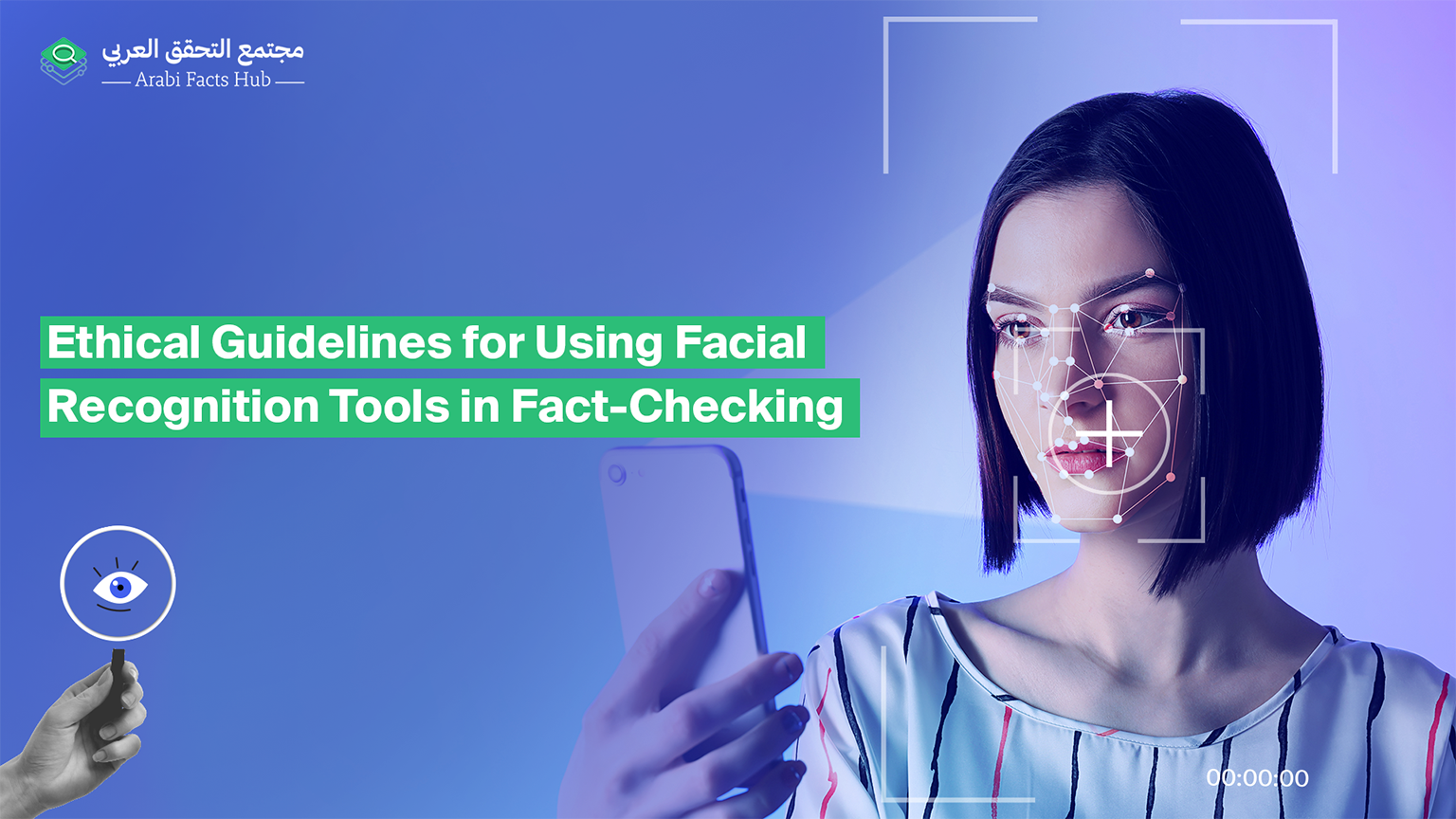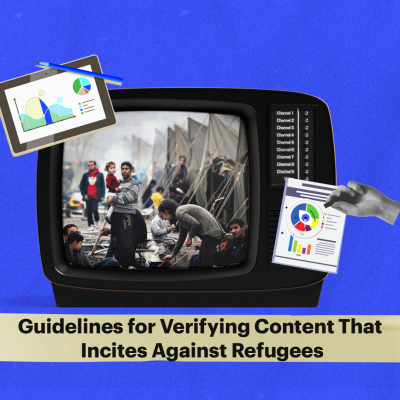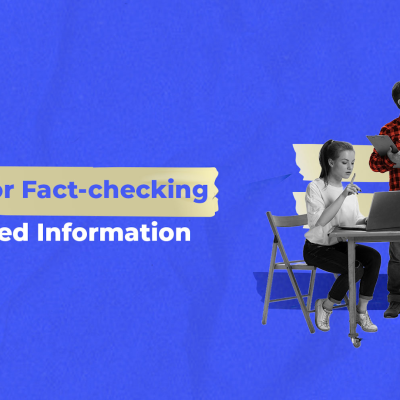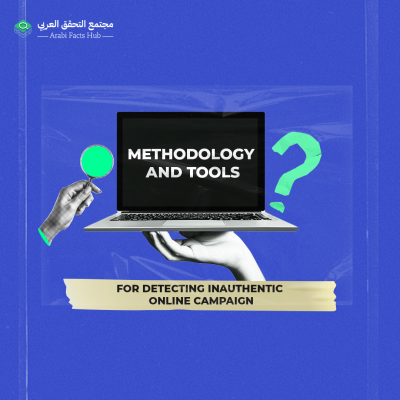Ethical Guidelines for Using Facial Recognition Tools in Fact-Checking

The rapid technological advancement of AI models used to generate images and videos has introduced new challenges for journalists and fact-checkers, particularly with regard to image and video manipulation. However, AI can also be harnessed to detect such manipulation through various techniques, such as facial recognition, which is especially useful for verifying identities and conducting investigative reporting which relies on tracking individuals.
This article outlines the methodology for using facial recognition technology in journalism generally, and in fact-checking specifically, while highlighting key tools and relevant techniques. It also discusses the limitations of these technologies and the ethical challenges they pose, which warrant careful consideration.
How to Use AI for Facial Recognition
Facial recognition applications rely on AI algorithms, machine learning, and artificial neural networks that can identify human faces within images and distinguish them from other elements, like landscapes or buildings.
The process begins by selecting photos or videos circulating on social media, where a fact-checker or journalist seeks to identify the individuals shown. They then isolate a specific segment and search for it using a facial recognition tool. The tool first processes the images or videos to enhance quality and remove elements that might hinder detection.
Next, algorithms focus on identifying the eyes, a prominent facial feature, and create a unique digital "fingerprint" for the face, which is matched against previously stored facial fingerprints. The search results yield a set of images featuring individuals who match or resemble the target image. Some tools also provide links to these images online, streamlining the process of identifying people and gathering relevant information about them.
Uses of Facial Recognition Technology
Facial recognition technology is used in several fields and can be integrated into various programs and applications, such as digital security, surveillance systems, and identity verification, to achieve the following purposes:
- Preventing unauthorized or unqualified individuals from entering secure or government buildings;
- Finding missing persons or tracking suspects;
- Managing access control, attendance, and departure, where facial recognition functions similarly to fingerprint identification;
- Identity verification for using equipment or accessing specific services;
- Financial applications and electronic identification (eKYC);
- Two-factor authentication (2FA) for devices and accounts, and protection against impersonation;
- Identifying travelers at airports and border checkpoints.
This technology is also starting to be used in advertising, where programs select the most suitable ads for users based on their appearance and mood.
Facial Recognition and Its Importance in Journalism and Fact-Checking
Recently, facial recognition technology has been introduced into journalism at the backdrop of the proliferation of AI-generated images of fictional characters and the spread of videos on social media depicting acts of violence and vandalism, often without identifying the responsible party or instigator.
Facial verification becomes especially crucial in critical times, such as conflicts, elections, disputes, and wars, when misinformation and political polarization are rampant. This technology is also employed in investigative journalism, particularly in stories that involve tracking finances and individuals. Such stories often require image analysis to map out a network of influential figures close to authorities or those involved in violent acts.
A team of journalists from the platforms Bellingcat and Insider used facial recognition technology, along with numerous open and closed sources, to identify those involved in the attempted assassination of Russian opposition leader Alexei Navalny.
How to Select and Choose Images for Facial Recognition Analysis
With the widespread "infodemic," journalists and fact-checkers may face challenges in prioritizing trending images or visual media that require examination with facial recognition tools to verify the identity of individuals depicted. It is recommended to operate based on four criteria: time, location, reach, and relevance. Time involves focusing on recently published videos and images, while location is crucial as it relates to the geographical area covered by the media organization. Reach adds significance to an event, encouraging fact-checkers to verify visual media and the individuals within. However, reach alone is not sufficient; it must be coupled with public interest to justify revealing the identities of individuals shown in the image/video.
It also becomes essential to have the skills and tools necessary to detect altered or AI-generated images, including:
- Familiarity with Editing Techniques
Basic knowledge of image editing programs can help identify potential manipulation signs in images, making facial recognition a preferred option for detection. Common signs include inconsistent lighting and unnatural shadows. - Using Image Analysis Tools
Examination can be done using image analysis software designed specifically for detecting manipulation. One such tool is the Adobe Photoshop suite, which allows detection of any edits or alterations. Additionally, reverse image search engines like Google can be used to trace the source of images and verify their authenticity, aiding in identifying images that require facial recognition technology.
The AI OR NOT tool can measure the likelihood of an image being AI-generated.
The versatile Sensity tool can be used to detect deep-fake manipulation in faces across various media, such as images, videos, and even voices in audio recordings.
- Paying Attention to Subtle Image Distortions
It is essential to consider signs of subtle distortions in images, such as irregular proportions, unnatural reflections, and abnormal sharpness. - Consulting Experts and Collaborating with Specialists
Consulting experts in the field of digital media analysis provides a more comprehensive perspective for facial verification, enhancing the accuracy of the fact-checking process.
Tools and Techniques for Facial Recognition in Images and Detection:
- Amazon Rekognition
This tool from Amazon provides face verification in images and videos using machine learning techniques. - Azure AI Video Indexer
This tool, when installed on devices, extracts information about elements in images, such as faces, helping to verify the faces in videos and images. - FaceCheck.id
This tool allows you to upload images and search for faces to identify them. - Betaface
This tool offers features for detecting image content, such as age, gender, and ethnicity of the faces displayed. - Pimeyes
This tool is a reverse image search engine that helps identify pages or platforms where the image has been previously published.
Limitations and Ethical Challenges of Facial Recognition Technology:
It is important not to treat the results of these tools as definitive, as they may not be accurate in all cases. The accuracy of these tools depends on the quality of the training data used during the machine learning process. If the data is incomplete or insufficient, the results may be prone to errors and inaccuracies.
For example, in an investigation conducted by Belgian journalists using Pimeyes to identify a man wearing military clothing, the tool failed to identify the correct person. Instead, it provided results of other individuals shown in the same image. Therefore, it is essential to gather evidence from multiple sources, recognizing that facial recognition tools may have limitations or flaws that affect their accuracy.
The development and availability of these technologies by various companies have raised growing concerns about individual privacy and digital identities, as these tools rely on collecting and analyzing biometric data without prior consent or approval from individuals. This highlights the importance of using these technologies responsibly.
Ethical Use of Open Sources in Investigations:
- Ensuring the Proper Data Collection in Tools Used
Journalists should spend sufficient time understanding the tools they use for facial recognition and the data these tools rely on, as well as any ethical concerns regarding data collection. If any results raise doubts or appear inaccurate, no decision should be made without further verification; either refrain from using the tool or rely on it partially, while conducting additional verification using other sources. - Compliance with Values of Transparency and Disclosure
This involves disclosing the tools used for verification, explaining the limitations of each tool, and how these limitations are addressed through additional verification sources, whether open or human-based. - Serving the Public Interest
It is crucial to ensure that facial recognition tools and their ability to reveal individuals' identities in journalistic stories or fact-checking reports are used for the public good. - Respecting the Right to Privacy
Respecting privacy and individuals' control over their data, ensuring its confidentiality, is a priority for journalists. When revealing the identities of people in images, the faces of others in the same image, who are not relevant to the investigation, should be covered. - Availing the Right of Reply
The right of reply is crucial, especially in investigations involving accountability. Individuals affected by the findings should be given the opportunity to respond to the investigation's results, ensuring fairness and justice.
This article is published in collaboration with the International Journalists’ Network IJNET









